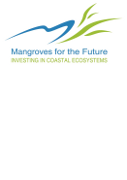Grants :: Small Grant Facilities :: Youth Power against Global Warming by Promotion of Seagrass Learning
Youth Power against Global Warming by Promotion of Seagrass Learning

Seagrass species Enhalus Acoroides (insert), possesses medic ... © GEF SGP Thailand/ Suwimol Serepaowong, 2013.
Objectives
1) To monitor ecological status of seagrass in project location to be used in demarcation of community conserved area
2) To launch campaign, add value and merit of seagrass through activities, nature classroom and eco-tourism
Background
Tung Nang Dam Coastal and Marine Resources Protection Group: Founded as a conservation group following participating in the mangrove conservation training organized by Mangrove Development Station 17. Successive workshops on surveying and monitoring seagrass, organized by IUCN and Phuket Coastal Research and Development Centre led to the group activities on seagrass status nearest to community (so called “seagrass in front of the house) since 2007.The activities had resulted in successful demarcation and management of seagrass in front the houses attracting attention of local administrative organizations towards sustainable natural resource management.
Target beneficiaries
110 out of 223 households in project location who earn living through fishery. The per capita income is THB 48,000.
Outputs
Expected Outputs
|
Main Activities (กิจกรรม) |
Main Anticipated Result (ผลที่คาดว่าจะได้รับ) |
|
1. Field activities on seagrass, mangrove and coastal ecosystem such as natural classroom, a survey and monitoring on changes 2. Launching workshops and study tours for capacity building 3. Launching campaigns, event and activities for raising awareness on seagrass and mangrove conservation by using creative art and traditional performance approach 4. Publishing creative media, photo, poster for dissemination |
1. Emergence of a youth group with holistic knowledge based of seagrass ecosystem to encourage communities and tourists for conservation 2. Emergence of a basic survey and monitoring method on seagrass and dugong of youth group 3. Emergence of creative media, photo, poster for dissemination 3. The area of seagrass about 700 sq.m. and mangrove of about 4 km. length along the village coast being surveyed, demarcated and monitored by youth group 4. Increased conservation awareness of youth group indicated by active communication with community members through traditional performance and by initiative to establish youth council of Kuraburi district 5. The project being incorporated in a district plan for eco-tourism |
Accomplishments and challenges
1) The sustainable activities of youth group toward knowledge transfer
2) Participation of 4 villages for planning conservation and sustainable use of natural resources, i.e. tropical forest, beach forest, peat swamp forest, savanna, mangrove etc. on Koh Prathong was a priority, by addressing the case study to regulate the plan
3) The communities need to have awareness and a follow-up plan on the situation and impacts of tourism investment, land exploitation and governmental project on Koh Prathong area
4) Weather condition was not supporting the project activities some time and caused a delay, especially in monsoon season. Congregating children for activity was rather difficult
Contributions to cross-cutting themes
Climate change
Throughout the project, both male and female were encouraged to discuss and share what they want to achieve in the project.
Communication
Poster on knowledge related to seagrass was produced through the community’s learning center.
Lessons Learned
1) The project referred to sectorial cooperation, as well as the youth group itself, as the most important factor leading to success. Direct confrontation with those who disagreed with the project should be avoided
2) Working with the youth need understanding about their capacity and limitation such as individual perception, interest, and responsibility by having them participate in project activities and make them as enjoyable as possible. Do not put pressure on them with high expectation and heavily academic substance, however, they should know the project goal and try to practice towards the goal
3) Importantly, building the capacity, learning and awareness for youths/students on holistic ecosystem made them perceive conditions/status of natural resources in the future and capable of initiating resources management plan
4) Some tools and IT devices were somehow essential for field activities, namely camera, GPS. The activity planning should be considered beforehand
Project Facts
Country
Location
An island of Baan Tung Nang Dum, Phang Nga Province’s Kuraburi District in the Andaman Sea & Baan Tha Pae Yoi, Phang Nga Province’s Kuraburi District, on Koh (island) Prathong of the Andaman Sea
Topic
Duration
19th Jun 2013 to 31st Aug 2013
MFF Grant Amount
300,000 THB
Co-financing Partner
|
From (งบจาก) |
In cash (เงินสด) |
In kind (แรงงาน สิ่งของเครื่องใช้ ที่ดิน ฯลฯ) |
|
North Andaman Youth Network |
35,000 |
12,000 |
|
North Andaman Community Tourism Network |
- |
12,000 |
|
Total (THB) |
35,000 |
24,000 |
Implementing Partner
Ms. Peeraya Suksa-ard, Project Leader, 12/1, Moo 5, Tung Nang Dam Village, Tambon Kura, Kuraburi District, Phang Nga Province, 82150.
Related Publications

Youth Power against Global Warming by Promotion of Seagrass Learning
Author: MFF Thailand
Posted on: 4th Dec 2013
Category:
Size: 864 KB